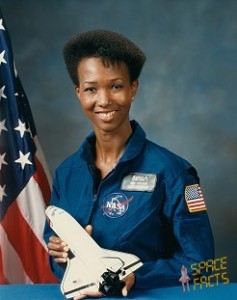Born in 1956 in Decatur, Alabama – the youngest of three children- to Charlie and Dorothy Jemison, Mae Jemison was the first African American woman to travel to space! Her father was a maintenance supervisor for charitable organization and her mother taught English and math. When she was three her family moved to Chicago.
In 1977, at the age of 16, Mae received a National Achievement Scholarship to go to Stanford University in Northern California. There she double majored in chemical engineering and African-American Studies. She went on to medical school at Cornell where she received her MD in 1981. Not one to shy away from challenges, she traveled to Cuba, Kenya and Thailand providing medical care to those in need.
Her medical training completed, she decided to continue the work that she had started earlier. She joined the Peace Corps and from 1983 to 1985 she was in West Africa. Her work in the Peace Corps took her to Sierra Leone and Liberia where she supervised the pharmacy, laboratory and medical staff. In addition, she worked with the Center for Disease Control and the National Institute of Health to research various vaccines for hepatitis B, schistosomaisis and rabies.
Before we even begin to talk about the later events of her life, she clearly provided a strong role model for others and a passion for humanity. Recognizing that commitment and her intelligence, in 1987 NASA asked her to be part of the Space Program. She completed her training a year later. In September of 1992 Jemison was assigned to be the Science Mission Specialist on the Space Shuttle Endeavor (STS – 47).
The Astronauts on this cooperative mission between the U.S. and Japan conducted experiments in life sciences and on material processing. In addition, they studied the effects of zero gravity on people and animals.
She was also involved in a special experiment concerning motion sickness. Realizing that about half the astronauts who travel to space get nauseous and motion sick, NASA trained Jemison in biofeedback techniques and meditation. She used only these instead of the typical medicines that astronauts take. Her response was carefully monitored and the experiment was a success.
In 1993 Mae Jemison left NASA to assist people in developing countries. She is a Professor of Environmental Studies at Dartmouth and heads the Jemison Institute for Advancing Technology in Developing Countries. Two projects that she has worked hard to make successful are improving health care in West Africa and getting youth involved in science.
Mae Jemison doesn’t sit still for long. Aside from running the Jemison Institute and teaching, she has an avid interest in languages. She speaks Russian, Japanese and Swahili fluently. In her spare time she enjoys jazz dance, photography and skiing. She lives in Houston with her cats Sneeze and Little Mama. Surely we will be hearing about Mae Jemison and the contributions she continues to make for a long time to come.
